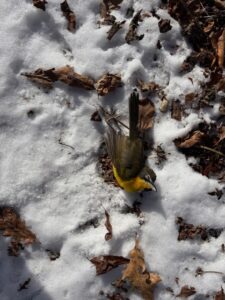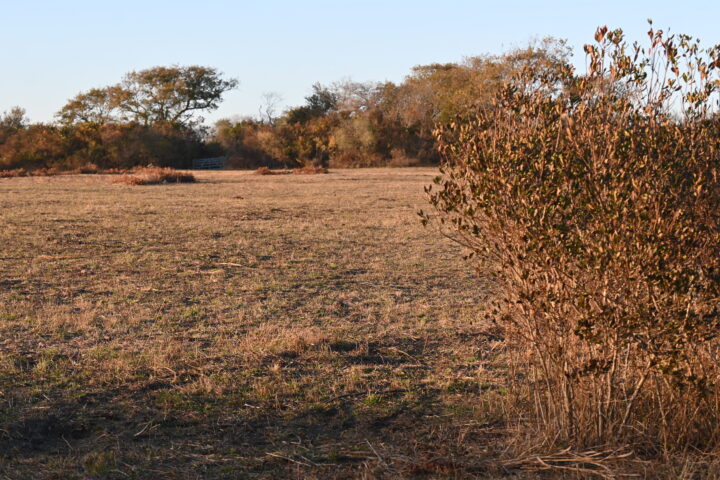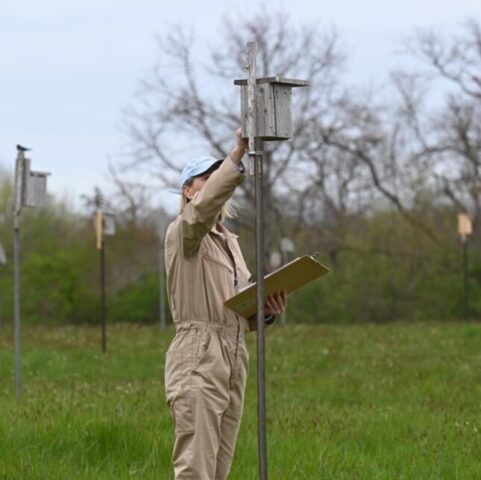Note: There is a photo included in this article that might be considered graphic to some. Take care when viewing.
While on a trail check during last week’s frigid weather, Norman Bird Sanctuary Director of Horticulture & Conservation Joye Whitney said, “I found a dead warbler on the Universal Trail yesterday.” No big deal I thought. Probably a Yellow-rumped Warbler, the one Warbler species that will overwinter here in large numbers. “I even have a picture,” she added. I took a look and my heart immediately sank. It was a Yellow-breasted Chat.

Most murder mysteries revolve around finding the perpetrator and the motive. Very few focus on why the victim was there in the first place. The motive and culprit in this case is easy: the victim, who should have been in Central America this time of year (Yellow-breasted Chat – Range Map – eBird Status and Trends), froze to death in the abnormally cold temperatures. The question is why was this Chat at the Norman Bird Sanctuary?
Our Chat was found along a section of the Universal Trail that abuts dense thickets of Multiflora Rose, Wineberry, and various shrubs. This is the typical habitat of a bird that spends its life secreted away in an impenetrable tangle of vegetation. In fact, it’s only rarely during the spring that males will emerge to the outer reaches of a thicket to sing for mates or to assert territorial boundaries. The latest edition of the Rhode Island Breeding Bird Atlas declares this species as no longer breeding in the state and there was only a single record of a male singing during the four-year period the Atlas data was being compiled. Was this bird bucking the trend, hiding out undetected during the summer months only to run out of the berries necessary to provide the needed fats to ensure survival in the winter cold?
Though difficult, it is not unheard of to find yellow-breasted chats in the winter. Members of their species have been found as far north as the Canadian Maritimes! A Christmas Bird Count on Cape Cod holds the national record with 17 chats observed. The Newport-Westport Christmas Bird Count, which includes NBS in the count circle, threatened that national record with 13 chats discovered in 2020. But why does a bird with a northern breeding range extent in the mid-Atlantic states fly north instead of south in the fall? And how many, unlike our unlucky chat, survive to fly south in the spring? Unlike some bird species that are expanding their range north as the climate warms, Yellow-breasted Chat breeding territories appear to be retreating southward.
The Yellow-breasted Chat itself is a bit of a mystery. With its olive-green back, white “spectacles,” and brilliant yellow breast, its coloration is like that of a warbler. It is, however, larger than a warbler, with a heftier beak, unlike the narrow dagger-like beaks typical of warblers. Scientists for many years did not know how to classify this species. Many bird guides group yellow-breasted chats with warblers, though its Latin name (Icteria virens) suggests that it belongs, despite its colorful feathers, in the blackbird family. Only in 2017 was it placed in its own family. The American Ornithological Society’s checklist now slots the Yellow-breasted Chat following Sparrows and ahead of Blackbirds.
Maybe some mysteries are not meant to be solved. The densest of thickets preferred by the Yellow-breasted Chat shrouds it in anonymity. Both in life and death.

